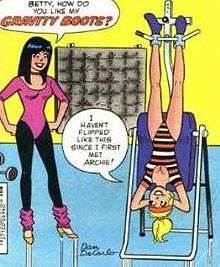Gravity boots

Gravity boots are ankle supports designed to allow a person to hang upside down. Thanks to exposure in television dramas and movies in the 1980s, gravity boots became a common fitness tool in homes across the United States.
Today, gravity boots are used by the U.S. Army and have experienced a surge in popularity in 2006 with The Da Vinci Code author Dan Brown praising them as well.[1] Several companies manufacture and market gravity boots under various trade names.
The purported benefits of gravity boots range from the relief of back pain and headaches to increased oxygen flow to the brain. Some people use gravity boots to add an extra challenge to workouts, doing inverted crunches or squats, while others such as Uri Geller use them to increase blood flow to the brain, in the belief that it facilitates thinking.[2]
Manufacturers
One manufacturer was Gravity Guidance, founded by Robert Martin, Jr. Their "Gravity Guidance System", which was developed by the founder's father, American physician, osteopath and chiropractor Robert Martin, Sr. The Gravity Guidance System was an inversion therapy system that allowed patients to hang upside down with the help of gravity boots and a metal bar wedged within a doorframe. The system gained widespread fame after it was used by Richard Gere in the 1980 movie American Gigolo.
The company benefited from this exposure and in 1983 was listed second among Inc. Magazine's Inc. 500 fastest-growing companies. However, the success was short-lived, as both lawsuits over injuries and the concerns expressed in medical publications about stroke risk and ocular pressure made the public wary of the health risks of inversion therapy. The system was probably no riskier than other exercise equipment, but consumers had lost confidence in the system and Gravity Guidance Inc., defaulted.
In 1984, Tim Elam, then a sales consultant for Gravity Guidance Systems, developed an inversion device that allowed for the user to get into the inverted position without the use of gravity boots. The Skyhook inverter marketing rights were sold to Universal Fitness Products and rolled out into the marketplace in the spring of 1984. Sales were brisk until concerns expressed by the medical industry lowered sales to the point that Universal also went out of business, along with several other companies who were promoting inversion and oscillation equipment.
Elam retained the patent pending and the marketing rights of the Skyhook Inversion and Oscillation System and continues to be a proponent of the benefits of oscillation therapy.
See also
| Look up gravity boots in Wiktionary, the free dictionary. |
References
- ↑ "Brown plays down Code controversy" BBC; 24 April 2006
- ↑ Women's Health; November 2000
Further reading
- "Hang Ten" TIME; May 2, 1983
- "Selling Relief" TIME; September 19, 1983
- Buchanan, Leigh. "Products of Their Times" Inc.com; September 2006
- Daily Breeze (Torrance, CA): "Warning given about fad of hanging upside-down – Using gravity boots may aggravate eye diseases", by Rex Dalton, Copley News Service, April 22, 1985.
- Detroit Free Press: Couple Sues Over Boots Injury", February 10, 1984.
- Klatz RM, Goldman RM, Pinchuk BG, Nelson KE, Tarr RS: "The effects of gravity inversion procedures on systemic blood pressure, intraocular pressure, and central retinal arterial pressure"; J Am Osteopath Assoc. 82(11), pp. 853–857 (1983). PMID 6885535
- Goldman RM, Tarr RS, Pinchuk BG, Kappler RE, Slick G, Nelson K.: "More on gravity inversion"; West J Med 141(2), p. 247 (1984). PMID 6238484
- Friberg TR, Weinreb RN: "Ocular manifestations of gravity inversion"; JAMA 253(12), pp. 1755–1757 (1985). PMID 3974054